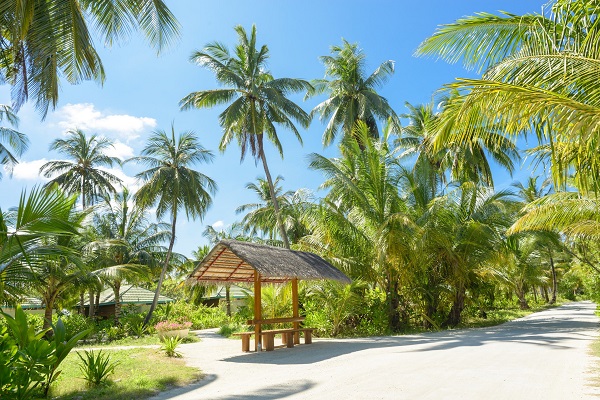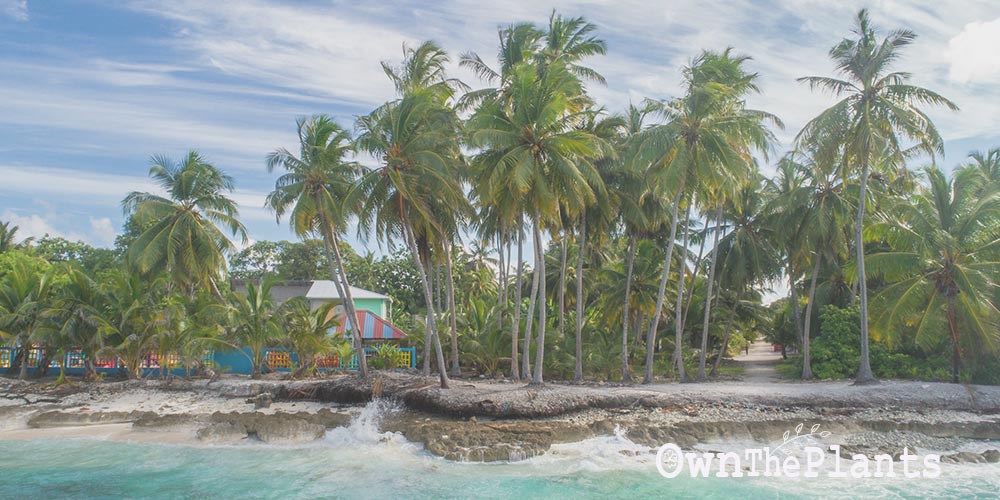Palm trees are among the historical plants that mankind owes a lot from. In more ways than not, palm trees have revolutionized the way we live for thousands of years. They have been a part of our lives and are integral to every nation’s development.
Palms are directly connected to the diverse cultures all throughout the world’s regions. We have been cultivating palms for their fruits, woods, and fronds as sources of shelter and food.
They are also so symbolic since they signify victory and many religious significance. No wonder why they are called the “Tree of Life”.
Indeed, the palms have touched every realm of our lives. But did you ever wonder where they originally come from?
We have the origin story of these famous trees in this article. Delve right in and we will take you where it all started!
Getting to Know Palm Trees
Palm trees are members of the perennial flowering family, Arecaceae, the palm family. They are mostly restricted to tropical and other subtropical regions.
They are easily distinguished by their large, evergreen foliage known as fronds, which can be fan-shaped or feather-like and are arranged on top of one unbranched, main stem.
There are a lot of economic uses for these trees. Oil, wines, waxes, resins, fibers, on top of woods and fruits, are just among the reasons why palm trees are cultivated widely. The palm trees surely have a significant economic importance.
However, although they are called “trees”, palm trees are not really true trees.
They are monocots like lilies, bananas, and grasses, which do not have the capability to increase girth like your real trees could. That is why they don’t have annual tree rings.
Where Are Palm Trees From?

To answer promptly, palm trees come from all around the world. This may come as a shock, but these trees are native to many world regions.
To date, there are a couple over 2500 species of palms, which are scattered in tropical, subtropical, and even temperate regions. Some palm trees have already adapted to cold environmental conditions.
However, before they become widespread, they first thrive in Africa, where they originated. In fact, the earliest palm tree fossils were found in parts of East Africa, dating all the way back to the Paleocene period.
With passage of time and because of rampant domestication, palm trees spread to other parts of the Earth.
That’s why you can now see them almost anywhere, but mostly in South America, Australia, Africa, and Asia.
Are Palm Trees Native To America?
The majority of species of palms that are found all over America are just introduced to the ecosystem, either due to intent or by accident.
Palms are not naturally occurring in the U.S. They could have been brought to the place by humans or they could have been spread by animals.
With the right climatic conditions, even non-indigenous species of palm trees like your Coconut Palms (Coco nucifera), can continue to survive, especially in the southern areas of North America.
Since their introduction, they have been continually cultivated for food, crafts, landscaping, and oil.
To give you more information on the Palm Trees that are found in America, we have listed the species that you can possibly find in the different US territories. Take a look at the US native Palm Trees below.
Palm Trees Found in the Continental US
With over 2,500 palm species all over the world, there are only 13 species that can be found in the continental region of the US. These species are the only ones that have adapted to the environmental conditions of this land.
Here are the 13 palm trees found in the continental US:
- California Fan (Washingtonia faliera)
- Dwarf Palmetto (Sabal minor)
- Texas Palmetto (Sabal brazoriensis)
- Cabbage Palmetto (Sabal palmetto)
- Mexican Palm (Sabal mexicana)
- Florida Thatch (Thrinax radiata)
- Florida Silver Palm (Coccothrinax argentata)
- Paurotis Palm or Everglades Palm (Aceolorrahaphe wrightii)
- Needle Palm (Rapidophyllum hystrix)
- Florida Royal Palm (Roystonea regia)
- Scrub Palm (Sabal etonia)
- Florida Cherry Palm or Buccaneer Palm (Pseudophoenix sargentii)
- Nearly extinct Miami Palm (Sabal miamiensis)
Palm Trees Found in the US Caribbean Islands Territories
There is only one palm tree that is native to the US territories in the Caribbean Islands, mainly in Puerto Rico and Virgin Islands. This is the Roystonea borniquena or most commonly known as the Puerto Rico Royal Palm.
Although there are other palm species that can still be found on these territories, only the Puerto Rico Royal Palm, or the Mountain Cabbage, is native to these regions.
Palm Trees Found in the US Hawaiian Islands

In the US Hawaiian Islands, the genus Pritchardia, which is commonly called Loulu, has 19 native species all over the region. This genus of Palms is specifically originated from the Pacific.
The most common species that is found in these part of US are the following:
- Pritchardia remota
- Pritchardia martii
- Pritchardia hillebrandii
The Pritchardia palms are big palms that can grow from 20 feet to 60 feet tall, depending on species.
These palms are known for their fan-shaped, feathery leaves that are silver on the undersides. Some species produce edible fruits like the Pritchardia madeniana and Pritchardia affinis, which are both called Kona.
You might like: Palm Trees 101: Why Are Palm Trees So Tall?
Where Do Palm Trees Naturally Grow in the U.S?
In the US, Palms thrive best in USDA Zones 12 to 13. Other more hardy palms can tolerate colder, seasonal range of temperatures and thus can grow in much wider zones including USDA zones 8 – 11.
Furthermore, in the continental US, palms grow in the north, as far as the Carolinas, and on the west, as far as Southern California.
Palm species that are native to the US grow in the states of Louisiana, Florida, Texas, Georgia, California, Arizona, and Hawaii.
What City in the US Has The Most Palm Trees?
It is hard to get an accurate approximate of the number of palm trees per US city. However, several cities are known to have plenty of palm trees in their areas.
Here are some of the US cities with the most palm trees around:
Miami, Florida

The landscape of Florida is filled with palms. You can find them in any city boardwalk, metropolitan yard, or street.
However, Miami is not the sole city where palm trees dominate the view. Jacksonville and Orlando are also both iconic and scenic cities for palm trees.
McAllen, Texas
Deemed as the “City of Palms”, McAllen City in Texas proved that cactus is not the only plant species in their landscape. McAllen is a wealthy host of naturally-occuring palms in the southern region of Texas.
However, Houston is also home to 3 native palms – the Texas Palmetto, Mexican Palm, and the Dwarf Palmetto.
Los Angeles, California
No one does not think of Los Angeles when talking about cities with palm trees. The iconic California Fan Palms in Beverly Hills found a home in L.A.
However, San Diego comes second for its beautiful streets lined with palms. Although the common Queen Palm (Syagrus romanzoffiana) are just introduced and not really native species.
Honolulu, Hawaii
The islands of Hawaii become extra breathtaking because of the variety of palm trees around.
A lot of varieties adorned the landscapes, including the elegant Bottle Palms (Hyphorbe lagenicaulis) and the Traveler’s Palm (Ravenala madagascariensis), which is non-native.
What is the Famous Street in LA with Palm Trees?
Los Angeles is famous for its palm-lined streets. The iconic Beverly Hills is lined with palms, which has become a great spot for tourists to take selfies and photos.
To go there, just take a stroll down Windsor Boulevard and stop between 4th Street and 5th Street. You will not just have a good view of the Hollywood sign, but also with the Beverly Palms.
Are Palm Trees Native in the Middle East?
Palm trees are not native in the Middle East. However, they can still be found thriving in the wild in many parts. Dates and Coconuts are among the most common palm species that thrive in this region.
For centuries, palm trees have been cultivated in the Middle East. They have become a popular landscaping plant in the region. Up to date, there are above 200 different palm trees documented here.
The oldest palm in the world, Phoenix dactylifera, is a date palm species that is found in the Middle East. This specific Date Palm hails from the land where modern day Iraq now stands.
It has since then been successful at spreading all over the world because of its economic significance and wide range of adaptive mechanisms to survive extreme environmental conditions.
Where Do Date Palms Come From?
Date Palms thrive best in arid regions that have low levels of humidity and a temperature range of 20°F to 95°F.
These economic palms are cultivated in various parts of the world but mainly in India, Pakistan, Northern Africa, Mexico, United States, and the Canary Islands.
Final Thoughts
Whether it may be for economic use or merely for ornamental purposes, palm trees have been able to dominate the landscapes of the world. They are all-rounders, hence the demand of these species.
As palms continue to be functional to humans, expect that numerous palm species will be spreading more far and wide.
As more studies are conducted to harness the maximum potentials of these so-called Tree of Life, these palm species will continue to dominate the tropical and subtropical regions all over the world.
We hope you have learned something new in this article. Share your thoughts in the comment section below. We would love to hear from you!
